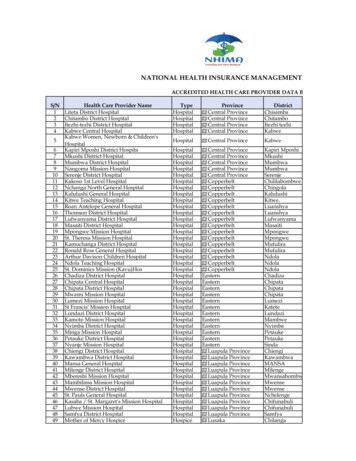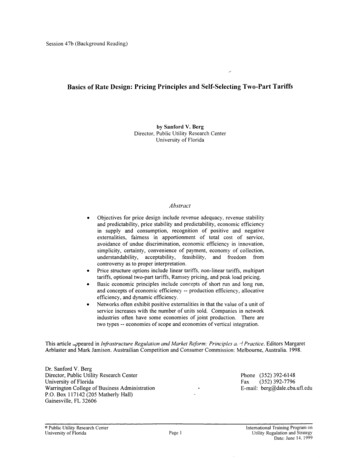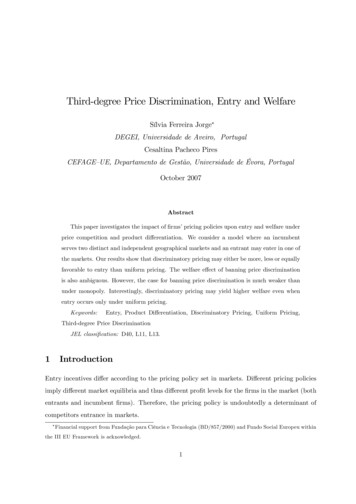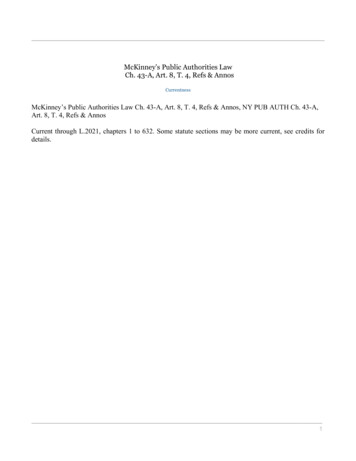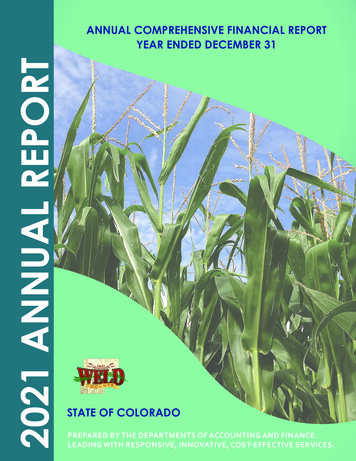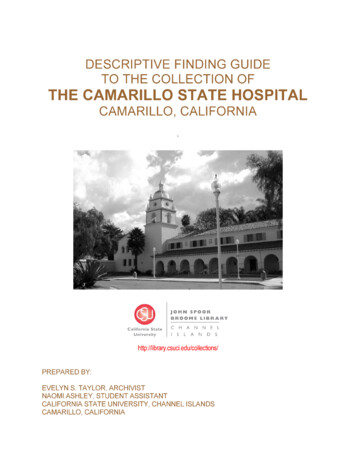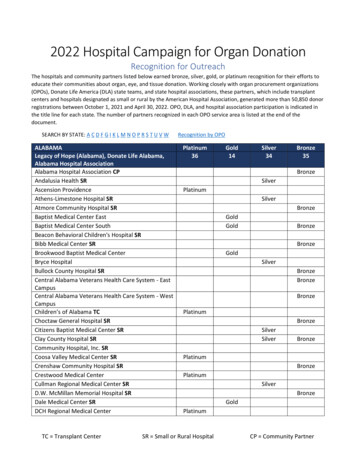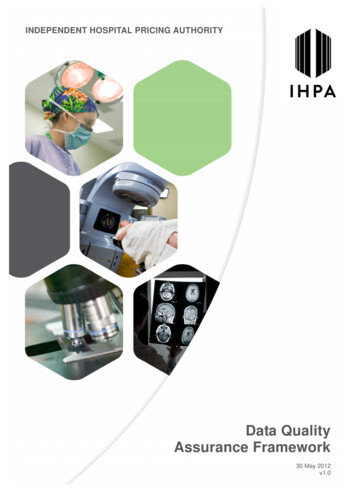
Transcription
INDEPENDENT HOSPITAL PRICING AUTHORITYData QualityAssurance Framework30 May 2012v1.0-1-
TABLE OF CONTENTSDefinitions3Acronyms and Abbreviations41. view555552. Quality Principles63. Roles and Responsibilities3.1 States and Commonwealth3.2 National Health Reform Bodies3.3 Independent Hospital Pricing Authority3.4 Stakeholder engagement3.5 Jurisdictional Advisory Committee3.6 ABF Technical Advisory Committee3.7 Advisory Working Groups3.8 Stakeholder Advisory Committee3.9 Transparency88891010101111114. ABF data processes and Quality Assurance checks4.1 Activity data classification quality assurance4.2 Activity data specification4.3 Activity data collection and analysis4.4 Cost data classification and specification4.5 Cost data collection and analysis4.6 Supplementary Data Requirements121314151617185. Quality Conformance Processes5.1 Reporting Jurisdictions compliance with data requirements5.2 Monitoring5.3 Communications5.4 National Efficient Pricing Quality Assurance process1919192020Appendix A: Data Quality Assurance Treatment SummaryA1. Data Quality Assurance Activity Data Classification DevelopmentA2. Data Quality Assurance Classification Systems and ActivityData CollectionA3. Data Quality Assurance NHCDC costing data classification andspecification and quality assurance measuresA4 Data Quality Assurance NHCDC costing data collection and analysis212122Appendix B – Data Quality StatementsB1- Data quality statement process- activity dataB2- Data quality statement templates- activity dataB3- Data quality statement process – CostingB4- Data quality statement template – Costing26262728302324Appendix C: Pricing Framework Submissions: - data quality quotes 31-2-
DEFINITIONSTermDescriptionClassificationsSystems of categories to which entities are assigned according toestablished criteria. Health classifications consist of hierarchicalsystems of codes. Classifications support data analysis.Data set specificationMetadata sets that are not mandated for collection [under theNational Health Information Agreement] but are recommended asbest practice*. IHPA uses the ABF Data Set Specification format tonominate its data requirements for production of the NationalEfficient Price.MetadataMetadata provide the underlying definitions and representation thatsupports collection, reporting and use of data within a specifiedcontext. For the national metadata registries, metadata isstructured information that describes data about aspects of thesystems the user community manages and for which they want tocompare and share information.*National Health DataDictionaryThe published Australian National Standard of data definitionsrecommended for use in Australian health data collections andNational Minimum Data Sets agreed for mandatory collection andreporting at national level. The NHDD is the authoritative source ofhealth data definitions used in Australia where national consistencyis required. The Dictionary is designed to improve thecomparability of data across the health field. It is also designed tomake data collection activities more efficient by reducingduplication of effort in the field and more effective by ensuring theinformation to be collected is appropriate to its purpose.National BodiesIHPA, NHPA, National Hospital Funding BodyNational Standards[for official statistics]Nationally approved rules for the development, collection,processing and dissemination of official statistics. They are a set ofcomponents which, when used together produce consistent andhigh- quality statistical output (about the concepts which underpinthe statistical variables) across collections and over time. Datastandards describe the agreed meaning and acceptablerepresentation of data for use within a defined context.*StatesStates and TerritoriesTerminologiesThe whole sphere of language used in the health system. Itincludes both Clinical Terminology and Classifications and theircomponents. A standard clinical terminology gives healthcareproviders a high level of confidence in the information that theyrecord, send and retrieve, ensuring continuity of care for patientsacross different times, settings and care providers.** from the National Health Information Agreement-3-
ACRONYMS AND ABBREVIATIONSTermDescriptionABSAustralian Bureau of StatisticsABFActivity Based FundingAIHWAustralian Institute for Health and WelfareAPCAdmitted Patient CareARDRGAustralian Refined Diagnosis Related GroupCACClinical Advisory CommitteeCOAGCouncil Of Australian GovernmentsCSOCommunity Service ObligationsDSSData Set SpecificationEDEmergency DepartmentEDWEnterprise Data WarehouseESEmergency ServicesIHPAIndependent Hospital Pricing AuthorityJACJurisdictional Advisory CommitteeLHNLocal Hospital NetworkMETEORMetadata online registryNAPNon-Admitted PatientNEPNational Efficient PriceNHCDCNational Health Cost Data CollectionNHFBNational Health Funding BodyNHRANational Health Reform AgreementNMDSNational minimum Data SetsNWAUNational Weighted Activity UnitPHEDPublic Hospital Establishment DataTACTechnical Advisory CommitteeTTRTeaching, Training and ResearchUDGUrgency Disposition GroupsURGUrgency Related Groups-4-
1. INTRODUCTION1.1 ContextThe Independent Hospital Pricing Authority (IHPA) isestablished under the National Health Reform Act2011 (‘the Act’) to determine the national efficientprice for health care services provided by publichospitals where services are funded on an activitybasis, determine the efficient cost for health careservices provided by public hospitals where servicesare block funded and to publish this and otherinformation in a report each year for the purposes ofinforming decision makers in relation to the fundingof public hospitals. This work is required to beevidence based and depends on access to highquality robust data.1.2 PurposeThe IHPA Data Quality Framework details IHPAprocesses to monitor and ensure best possible dataquality. This is a supplement to the 3 year data plan.The IHPA data quality arrangements are part of thebroader IHPA Quality Management Framework,including systematic arrangements for service andquality, risk management, human resource, finance,information technology, standards compliance, androles and responsibilities for all those involved inquality management.1.3 ObjectivesThe objectives of the IHPA Data Quality AssuranceFramework are to: establish the overarching principles andguide to action for IHPA with respect toachieving data quality assurance; implement a uniform approach to qualityassurance arrangements for the collection ofdata for calculation of the national efficientprice; promote a quality assurance culture withindata collection and analysis systems at theIHPA; and contribute to good corporate governancepractices with regard to data management.1.4 ReviewThe Chief Executive Officer (CEO) and PricingAuthority will review the IHPA Data QualityAssurance Framework, including associateddocumentation, annually and as required (e.g.following legislative changes). This review willensure the Framework remains current to supportIHPA in managing its business operations and toguide continuous improvement in IHPA’s datagovernance arrangements.-5-
2. QUALITY PRINCIPLESThe IHPA is committed to putting in place systematic and transparent data quality assurance systems. The IHPAis aware that a data quality standard (ISO8000-Data quality) is under development, and considers that this is notyet sufficiently mature for adoption. Instead, the IHPA has taken a broader quality perspective and adapted somedata principles from the broader definitions of quality provided in ISO9000.The IHPA will, apply the following quality principles in establishing and managing its data quality assurancesystems. These principles are outlined in Table 1.Table 1: Data Quality PrinciplesQuality ManagementPrinciples1CustomerfocusData Quality StatementQuality Management MechanismsThe IHPA depends on thecommunity and decisionmakers in jurisdictions as itscustomers and will strive tounderstand their current andfuture needs, meet theirrequirements and exceed theirexpectations.IHPA has a core commitment to transparencyand will be publish its work to improve publicconfidence in how our public hospital servicesare funded and the accountability of Australianpubic hospitals.The IHPA has established formal mechanismsfor consultation with jurisdictions including theJurisdictional Advisory Committee (JAC), ABFTechnical Advisory Committee (TAC) and ABFworking groups to understand the Jurisdictionsrequirements (these are detailed in the dataplan).In addition, submissions from jurisdictions anddirections from Ministers will inform the datacollection activity of the IHPA.23LeadershipInvolvementof peopleThe Pricing Authority and theIHPA Chief Executive willestablish unity of purpose anddirection of the organization,and will create and maintainthe internal environment inwhich people can become fullyinvolved in achieving theIHPA’s objectives.People at all levels of staff,stakeholder engagement andexpert contribution are theessence of the IHPA and theirfull involvement will enabletheir abilities to be used toensure high quality and valuein IHPA’s determinations.-6-The Pricing Framework will establish theprinciples that will inform calculation of theefficient price. The IHPA Data Plancommunicates IHPA’s data requirements overthe next three years to Jurisdictions and othergovernment agencies and describes themechanisms, including timelines that IHPA willuse to collect data from the Jurisdictions.The Data Quality Framework identified the keypoints at which data quality assurancemechanisms are applied and the key principlesapplied by the IHPA in its data quality assurancemechanismsThe IHPA has established internal processes forensuring staff, stakeholder and key technicalexpertise engagement in data management,including identifying key personnel, establishinggovernance, consultative and reportingmechanisms.Data quality assurance affects staff at all levelsand is a fundamental underpinning of theintegrity of the National Efficient Price.
4ProcessapproachThe IHPA will manageactivities and related resourcesas a process to ensure desiredresults are achieved moreefficiently.The rolling 3 year data plan prepared annuallyby the IHPA details the data collectionprocesses that will apply to data qualityassurance by the IHPA for each ABF-specificdata collection.6Systemapproachto datamanagementThe IHPA will identify,understand and manageinterrelated data processes asa system to contribute to theIHPA’s effectiveness andefficiency in achieving itsobjectives.The IHPA is using existing data mechanismsand national data processes where possible.The IHPA is working with other national bodiesand jurisdictions to rationalise data collectionsdetailed in the annual data plans. Data qualityassurance processes identified by theframework are incorporated into this framework.7ContinualimprovementThe IHPA has a permanentobjective to continualimprovement of theorganization's overallperformance.The IHPA has committed to a systematicprogram of work as articulated in the three yeardata plan. This will include a systematicapproach to data quality improvement in linewith this framework.8Factualapproachto decisionmakingEffective decisions are basedon the analysis of data andinformation.The IHPA has committed to an evidence basedapproach that relies on best available datainformed through its committee structures andresearch. Prioritisation of classification and dataspecification requirements will be informed bydata quality improvement sThe IHPA and its datasuppliers (includingjurisdictions and other nationaldata collection agencies) areinterdependent and a mutuallybeneficial relationshipenhances the ability of both tocreate value.IHPA has established committees to gain adviceregarding the Activity Based Data requirements.In addition, the IHPA is actively engaged inbuilding relationships with states and othernational agencies.-7-Jurisdictions have emphasised the importanceof a collaborative approach to data qualityimprovement in recent submissions to the IHPAon the pricing framework.
3. ROLES AND RESPONSIBILITIES3.1 States and CommonwealthUnder the NHRA, the Commonwealth and the Statesare jointly responsible for collecting and providingdata to support the objectives of comparability andtransparency, and to ensure that data are sharedbetween relevant participants in national health carearrangements to promote better health outcomes.Commonwealth funding for public hospital services isdependent on the provision of data requested by theNational Bodies (including the IHPA), including inrelation to services to patients, information identifyingthe patient to whom the services were provided, thepublic or private status of the patient, the nature of theservice and the facility providing the service.The Commonwealth and the States are responsiblefor data integrity within their systems and agree toestablish appropriate independent oversightmechanisms for data integrity, to provide certainty tothe Australian public about the actual performance ofhospitals and other parts of the health system. Statesand Territories, as hospital system manager areresponsible for data integrity, including ensuring thatstate data complies with specified standards andformats. The key additional elements of data integrityare accuracy and completeness.In December 2011, the Commonwealth and theStates have agreed a National Health InformationAgreement (NHIA) that establishes principles,governance and processes for Commonwealth, Statehealth and statistical authorities to work together toimprove, maintain and share national healthinformation. The IHPA, while not a signatory to thisNHIA is obliged under clause 132 of its Act to haveregard to any intergovernmental agreement relevantto the performance of its functions and an agreementgoverning national health information would appear tomeet this criteria. The IHPA will work to align itsfunctions with arrangements under the NHIA, notingthat its obligations under the NHRA and its Act haveprimacy.-8-3.2 National Health ReformBodiesThe National Health reform Agreement requires thatnational bodies will determine their datarequirements with reference to the following. ANational Body must: seek to meet its data requirements throughexisting national data collections, wherepractical; conform with national data developmentprinciples and wherever practical useexisting data development governanceprocesses and structures, except where todo so would compromise the performance ofits statutory functions; allow for a reasonable, clearly defined,timeframe to incorporate standardised datacollection methods across all jurisdictions; support the concept of ‘single provision,multiple use’ of information to maximiseefficiency of data provision and validationwhere practical, in accordance with privacyrequirements; balance the national benefits of access tothe requested data against the impact onjurisdictions providing that data; and consult with the Commonwealth and Stateswhen determining its requirements.The National bodies’ three year data plans, onceagreed through the Standing Council on Health, giveeffect to these arrangements. The National bodiesare also establishing formalised mechanisms forimproving conformance with these principles and inparticular working to minimise the data burdensimposed by their related roles.The data quality assurance plan has been preparedto be consistent with the IHPA data plan and toconform to these broader requirements, and notimpose an excessive administrative burden.
i.data and coding standards to supportuniform provision of data; andii.requirements and standards relating topatient demographic characteristics andother information relevant to classifying,costing and paying for public hospitalfunctions; andf) except where otherwise agreed between theCommonwealth and a State or Territory – todetermine the public hospital functions thatare to be funded in the State or Territory bythe Commonwealth.3.3 Independent Hospital PricingAuthorityThe IHPA, through functions provided under theNational Health Reform Agreement plays a pivotalrole in the national introduction of Activity BasedFunding (ABF), by:a)b)c)d)e)determining the national efficient price forhealth care services provided by publichospitals where the services are funded on anactivity basis;determining the efficient cost for health careservices provided by public hospitals where theservices are block funded;determining adjustments to the national efficientprice to reflect legitimate and unavoidablevariations in the costs of delivering health careservices;developing and specifying classificationsystems for health care and other servicesprovided by public hospitals;determining data requirements and datastandards to apply in relation to data to beprovided by Jurisdictions, including:The IHPA refers the task of developing data qualitystandards to the CEO and the Commonwealth publicservants and other staff under his responsibility. Thisdevelopment advice is used by the IHPA indetermining data requirements and data standardsthat Jurisdictions will use to collect and deliver datato the IHPA. In determining these requirements,IHPA and its staff will consult with Jurisdictions andother stakeholders, and is subject to the direction ofthe Standing Council on Health in relation to thenature of the data to be collected.Table 2: Data Quality Assurance Roles & ResponsibilitiesRoleData Quality Assurance ResponsibilitiesPricing AuthorityThe Pricing Authority provide leadership on data quality and are responsible for functions providedunder the Health Reform Act, including responsibility for ensuring data quality systems are in placeto satisfy their statutory obligations. The Pricing Authority is responsible for determining datarequirements that will underpin activity based fundingChief ExecutiveThe IHPA Chief Executive (CEO) leads and manages the IHPA, including driving change andimprovement through implementing ABF. The CEO is also the data custodian for the IHPA and hasresponsibility for oversight of data quality assurance.Executive Director,Activity BasedFundingThe Executive Director, Activity Based Funding is responsible for overseeing the design of anactivity based funding system for Australian public hospitals including coding and classification ofhospital services, costing of those services and development of pricing and funding models andpreparing appropriate recommendations to IHPA for the final endorsement of components of theactivity based funding system. This includes ensuring ABF data quality process implementation.Director, DataAcquisitionsIs responsible for the end-end data acquisition cycle, from specification to provision of high qualitydata sets for users within the IHPA. This includes Developing Data Set Specifications, in conjunctionwith jurisdictions, other agencies (National Health Performance Authority, National Funding Body,Australian Commission on Safety and Quality in Health Care) and acquiring, validating and loadinghigh quality activity and cost data sets for use by IHPA technical teams.Director, TechnicalFunding and PricingModelsIs responsible for development of the efficient pricing model using activity data, costing data andother data and relevant information. The price model will be strongly influenced by the quality of thedata submitted.Director, HospitalCostingIs responsible for all components of the NHCDC from specification and design to finalisation of costresults- across all product streams including a rolling strategy for future processing requirements.This includes responsibility for quality assurance, including development of the Costing QualityFramework.-9-
3.4 Stakeholder engagementAdvisory committees and working groups have been established to ensure that the Jurisdictions are consultedand that the public hospital funding health reforms are implemented efficiently. Figure 1 provides an overview ofthe committee structure that has been established to facilitate consultation regarding the specification andcollection of IHPA’s data requirements.Figure 1 - Committee and Working Group Data Requirement responsibilitiesAccountable for Data Requirementsand Standards DevelopmentIHPAOverall GuidanceJurisdictionalAdvisoryCommittee3 Year Data PlanABF TechnicalCommitteeData Set SpecificationsNHCDC WorkingGroupEmergency CareAdvisory WorkingGroupSub Acute CareAdvisory WorkingGroupNon-AdmittedAdvisory WorkingGorupMental HealthAdvisory WorkingGroupIn particular, IHPA uses these committees and working groups to: understand the impact on Jurisdictions of collecting the IHPA required data;consult on timelines to incorporate standardised data collection methodologies;encourage and facilitate processes that will ensure data accuracy; andreview preliminary results from hospitals and provide assistance in quality assurance.An overview of the responsibilities of each committee is provided in the following sub-sections.3.5 Jurisdictional AdvisoryCommittee3.6 ABF Technical AdvisoryCommitteeThe Jurisdictional Advisory Committee (JAC) is astatutory committee established by the Act.Consisting of a chair and nine other members (oneeach for the Commonwealth and the eight Statesand Territories), the JAC advises IHPA on issuesregarding classification systems, adjustments to theNEP, data standards and requirements and hospitalfunding models. The JAC can also provide advice onany other matters referred to it by the IHPA. The Actstipulates that the IHPA must “have regard to theadvice provided by the JAC”.The ABF Technical Advisory Committee (TAC) is aninternal committee created by IHPA to provideadvice on technical matters related to theimplementation of a national ABF framework. Inparticular, this includes the creation andmaintenance of classifications and data collectionsused for ABF purposes. This committee alsoconsiders issues related to the pricing models usedto calculate the NEP each year.- 10 -
3.7 Advisory Working GroupsTo assist the TAC in its objectives, working groupshave been established, one for each servicecategory. These working groups containrepresentatives from each Jurisdiction and aim toreach national agreement on technical issuesspecific to that service category. For example, theEmergency Care Advisory Working Group may beinvolved in discussing potential changes to theUrgency Related Groups (URG) classification usedfor patients treated in Category 3B emergencydepartments and above.3.8 Stakeholder AdvisoryCommitteeThe IHPA has established a Stakeholder AdvisoryCommittee (SAC) to act as a liaison point for peaknational health advocacy bodies and the IHPA. TheSAC will advise the IHPA of developments within thehealth industry that will be relevant to the functionsof the agency, the likely effects on the healthindustry of the decisions of the upcoming decisionsof the IHPA and to advise on contemporary pricingstrategies for public hospital services and bestpractice from other health care sectors such as theprivate hospital sector.3.9 TransparencyThe IHPA has committed to transparency inperforming its functions. The IHPA will publishinformation detailing its work and methodology.Some material will not be published, with decisionson release informed by data release principles inaccordance with statutory obligations and consistentwith Freedom of Information arrangements.The IHPA will actively seek and have regard tosubmissions from the public in performing its work.The IHPA will also introduce a procedural approachto resolving issues with ABF classifications, codingand data specification and collection to enableissues with data to be flagged and addressedthrough the annual data cycles provided in the dataplan.- 11 -
4. ABF DATA PROCESSES ANDQUALITY ASSURANCE CHECKSTo calculate the NEP, activity and cost data must be collected from the Jurisdictions. Once collected, those dataare analysed by IHPA using a pricing model. In collecting these data, a number of data sets are used. Whereverpossible, IHPA has used pre-existing classifications and data specifications, with additional data items addedwhere needed for ABF purposes.Figure 2 – Overview of ABF data processAs noted in the Victorian submission on the draftPricing Framework, the current data holdings havesome quality constraints, including:Other submissions made similar commentson data quality, and a sample of these areincluded in Appendix D. The qualityframework is not intended to fix all of theseimmediately, but rather articulate ongoingquality assurance process that will deliverimproved data over time, through amethodical approach to data improvement. Itis also intended to provide a framework foracknowledging, measuring where possibleand establishing priority areas for improvingthe data precision sensitivity.the development of new classificationsystems underpinned by data collectionsbeing undertaken for the first time; andlimitations to the accuracy and the fitness forpurpose of National Health Cost DataCollection (NHCDC) underpinning the NEP,and the reliance on data from otherjurisdictions that is being used for the firsttime for ABF purposes.11.- 12 -Page 4, Victorian Government SubmissionIHPA Draft Pricing ing.nsf/AttachmentsByTitle/submissions/ FILE/Victoria-Final.pdf )
4.1 Activity data classification quality assuranceThe IHPA collects activity data for all public hospital services from states and territories. The Classificationschosen for use in activity based funding are those that are currently available to best meet the current activityneeds. These will be updated periodically to ensure that they remain clinically relevant and explain variation inresource usage within a service category. The process for updating classifications is ongoing and iterative andwill have embedded quality assurance measures. The following table provides a simplified process of how theseupdates are progressed on the basis of best available evidence and appropriate governance arrangements.Table 3: Activity Data Classification Development and quality assurance measuresNoTask.Quality assurance measures1Data Current data on relevant hospital activity and costs and existingclassifications (if applicable).Accurate recent data used to informclassification work.2Submissions for classification changes - The IHPA will call forsubmissions to change classification systems. Submissions will becalled for via the JAC, TAC and working groups and can be made aspart of the annual public submissions process. The IHPA can alsoinitiate changes to classifications.Effected parties can contributeto development of accurateclassifications to ensure these arefit for purpose.Jurisdictions will create submissions and forward them to the IHPA viathe JAC, TAC and working groups or the annual submission processes.3Receipt of submissions and initial assessment - All submissions willundergo an initial assessment by the IHPA to identify how to prioritiseand evaluate the proposed changes. Decisions on priorities will beinformed through the IHPA committee structures.The IHPA will take a proceduralapproach to evaluations, throughlogging submissions and tracking theirprogress.4Advice on submissions will be sought as appropriate from:The Clinical Advisory Committee (CAC) will provide advice on clinicalaspects of proposes changes.Input from experts with expertise inappropriate technical or clinical areaswill inform classifications.The JAC, TAC, and/or working groups can be consulted as required tounderstand impacts on the Jurisdictions.External experts and consultants to undertake projects related topolicy analysis, stakeholder consultation or statistical modelling (forexample subacute cost driver analysis by PWC and preparation ofARDRG version 7 by Wollongong University).5Research -The IHPA will conduct or commission analysis to determinethe impact of the proposed change. This analysis will depend on thetype of changes proposed. For example, classification system changesrequire previous year’s data to be reorganised against the proposedclassification to understand the impact of the changes.The IHPA will ensure that analysis isreproducible and correctly interprets theproposal.6Proposal validation -The IHPA will develop a change proposal takinginto account the recommendations from CAC, JAC, TAC, workinggroups, and stakeholders referencing the analysis.The change proposal will bedocumented and submitted throughappropriate governance channels, inaccordance with timing specified in the3 Year Data Plan.7Determination of classification changes - The IHPA will evaluatethe results from the consultation and makes a decision on the changeproposal to eithera) Implement the change in the next versionb) Hold over changes to the next releasec) Or reject the proposal.The decision will be recorded along withinformation on the rationale for thedecision and future work on identifiedtopics.8Publication -The IHPA will publish updated classifications with detailsof changes included in the new version.The classification update will accuratelyreflect the policy intent and will includedetails of changes between versions.- 13 -
4.2 Activity data specificationIHPA issues ABF data set specifications that provide the Meta Data necessary for states and territories to collectnationally consistent activity data. The ABF data set specifications are developed in the METEOR environment byappropriately trained staff in accordance with processes developed by the AIHW in accordance with ISO/IEC11179 - Metadata registries (MDR). This standard addresses the semantics of data, the representation of data,and the registration of the descriptions of those data. It is through these descriptions that an accurateunderstanding of the semantics and a useful depiction of the data are found. The data set speci
3.3 Independent Hospital Pricing Authority 9 3.4 Stakeholder engagement 10 3.5 Jurisdictional Advisory Committee 10 3.6 ABF Technical Advisory Committee 10 3.7 Advisory Working Groups 11 3.8 Stakeholder Advisory Committee 11 3.9 Transparency 11 4. ABF data processes and Quality Assurance checks 12
